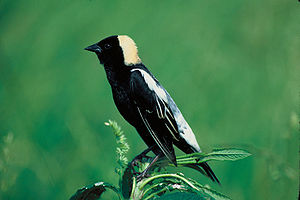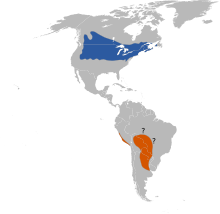Rice blackbird
| Rice blackbird | ||||||||||||
|---|---|---|---|---|---|---|---|---|---|---|---|---|

Male ricebird ( Dolichonyx oryzivorus ) |
||||||||||||
| Systematics | ||||||||||||
|
||||||||||||
| Scientific name of the subfamily | ||||||||||||
| Dolichonychinae | ||||||||||||
| Ridgway , 1902 | ||||||||||||
| Scientific name of the genus | ||||||||||||
| Dolichonyx | ||||||||||||
| Swainson , 1827 | ||||||||||||
| Scientific name of the species | ||||||||||||
| Dolichonyx oryzivorus | ||||||||||||
| ( Linnaeus , 1758) |
The bobolink ( Dolichonyx oryzivorus ), also Bobolink called, is the only extant species in the bird genus Dolichonyx and belongs to the family of blackbirds (Icteridae). The name Bobolink, which is used mainly in English-speaking countries, goes back to the singing of this type, which is described as Bob-o-liiiii .
Appearance
Ricebird are 18 to 20 centimeters large field, meadow and prairie birds. Adult ricebirds have short, black, finch-like bills. Females have light brown plumage with black stripes on their backs and flanks. There are dark gray to black stripes on the head; the wings and the tail are slightly darker than the rest of the plumage. Young animals have a similar plumage. The polygamous males have a black breeding dress with a white rump and white stripes on the wings. The cream-colored to yellow plumage on the neck and back of the head is characteristic. As winter plumage, they take on a plumage similar to that of the females.
Distribution area
The distribution area extends from southern Canada to Pennsylvania , Colorado and California . They move to South America to winter . Blackbird are long-distance hikers and cover distances between 12,000 and 18,000 (sometimes up to 20,000) kilometers. The blackbirds are capable of this through their fat reserves. From Florida the blackbirds fly over the Caribbean to Colombia and Venezuela and on to Argentina and Paraguay . They also occur as rare guests in Western Europe .
Reproduction
The female places the shell-like nest well hidden in the dense vegetation on the ground. The clutch consists of four to six eggs that are hatched over a period of around 13 days. Both parent animals participate in the rearing of the young, which fledge after 10 to 14 days.
They feed mostly on insects and seeds. They sometimes invade rice paddies in large groups and cause considerable damage to the annoyance of farmers. They used to be killed by the thousands in North America and used as food. In South America they are still killed or captured and sold as cage animals today.
Duration
Populations in North America have declined sharply since 1900 as many farms were abandoned and former meadows and fields were turned into forests. In addition, the most modern mowing technology brings in the harvests earlier and more frequently, so that many young birds that have not yet fledged have no chance of survival. The decline in the breeding population of blackbirds is estimated at an annual average of 4.5 percent for the period from 1966 to 2000.
The most numerous were the blackbirds at the end of the 19th century, when horses were used for locomotion and extensive hay fields were laid out to feed them. The picture is different in South America. Due to the creation of many rice fields, the birds are even more numerous there than in North America.
Web links
- Dolichonyx oryzivorus in the endangered Red List species the IUCN 2008. Posted by: BirdLife International, 2008. Accessed January 31 of 2009.
- Videos, photos and sound recordings of Dolichonyx oryzivorus in the Internet Bird Collection
Individual evidence
- ^ Paul A. Johnsgard: Great Wildlife of the Great Plains . University Press of Kansas, 2003, ISBN 0-7006-1224-6 , p. 42
- ^ Paul A. Johnsgard: Great Wildlife of the Great Plains . University Press of Kansas, 2003, ISBN 0-7006-1224-6 , p. 43

